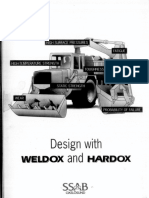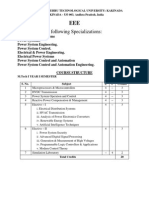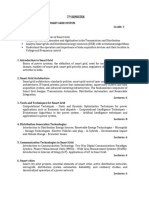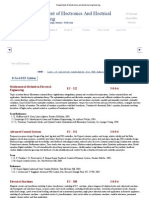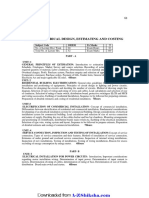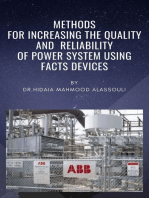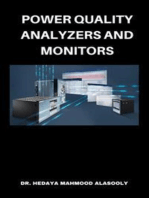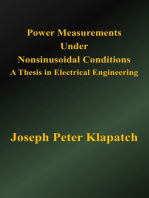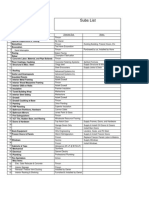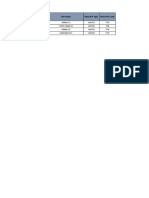Nptel: Power Electronic Applications in Power Systems - Web Course
Nptel: Power Electronic Applications in Power Systems - Web Course
Uploaded by
Tiya gonekarCopyright:
Available Formats
Nptel: Power Electronic Applications in Power Systems - Web Course
Nptel: Power Electronic Applications in Power Systems - Web Course
Uploaded by
Tiya gonekarOriginal Title
Copyright
Available Formats
Share this document
Did you find this document useful?
Is this content inappropriate?
Copyright:
Available Formats
Nptel: Power Electronic Applications in Power Systems - Web Course
Nptel: Power Electronic Applications in Power Systems - Web Course
Uploaded by
Tiya gonekarCopyright:
Available Formats
NPTEL Syllabus
Power Electronic Applications in Power
Systems - Web course
COURSE OUTLINE
Usual application areas of power electronics include power supplies and motor
drives. Availability of high power electronic switches has enabled deployment of
NPTEL
power electronics for improved operation of the ac transmission and distribution http://nptel.iitm.ac.in
networks.
This course primarily serves to highlight the requirements of modern
transmission and distribution systems and specific power electronic solutions to Electrical
realize them. Transmission system behaviour is analyzed in great detail in the
basic and advanced courses on power systems.
Engineering
This course begins with a recapitulation of the principal results of this analysis
as well as an introduction to the concept of power quality. The desirable features
of a compensator is mentioned to develop a designer's perspective. Pre-requisites:
Subsequently, the power electronic solutions are sequentially introduced in
increasing order of complexity and compensation capability. For each solution,
the circuit schematic and basic operation is detailed. 1. Power Electronics (Advanced).
2. Power Systems I.
The compensation capability and limitation are logically stated. Steady-state and
dynamic equations- wherever applicable- are included to provide a logical basis
for a designer to evaluate the performance of each such solution in the power Additional Reading:
network.
1. Erwin Kreyszig, “Advanced
Contents: Engineering Mathematics”,
McGraw Hill.
Review of transmission lines, radial & symmetrical lines, shunt & series
compensation; FACTS & Power Quality; SVC: TCR, FC-TCR, TSC-TCR 2. John J D'Azzo & Constantine H
variants; STATCOM: circuit, operation & control, active filters, hybrid active Houpis, “Linear Control Systems
filters; TCSC: circuit, operation & control, critical modes; DVR: circuit, operation, Analysis & Design”, McGraw Hill.
control modes; UPFC: circuit, operation, steady-state behaviour and dynamic
control, advantage over previous compensators; IPFC: circuit, steady-state 3. T. J. E Miller, “Reactive Power
behaviour and control, advantage over UPFC. Control in Electric Systems”,
John Wiley & Sons.
COURSE DETAIL 4. N. Mohan, T. M. Undeland & W.
P. Robbbins, “Power
Electronics”, John Wiley.
Sl. Topic No. of
No Hours Coordinators:
Dr. P. Sensarma
Department of Electrical
1 Review of transmission lines; surge impedance loading; 09 EngineeringIIT Kanpur
voltage profile along radial and symmetrical lines, effect
of load, Ferranti effect; role of reactive power
compensators; series, shunt and unified compensation;
effect on power flow and voltage profile; FACTS;
Requirements of distribution systems, power quality (PQ)
problems and classification, numerical indices of PQ.
2 The Static Var Compensator (SVC); TCR, FC-TCR and 04
TSC-TCR variants: circuits, characteristics; transmission
line compensation capability; dynamic model.
3 The Static Compensator (STATCOM): circuit and steady- 08
state characteristic; effect on transmission line
compensation; advantages over SVC; the D-STATCOM
and its use in power quality compensation; reactive
power compensator; control; active filtering for harmonic
compensation; hybrid active filters.
4 The Thyristor Controlled Series Compensator (TCSC); 05
circuit and steady-state characteristic; effect on
transmission line compensation; critical aspects of
operation; the NGH damper.
5 The Dynamic Voltage Restorer (DVR); circuit and steady- 06
state characteristic; effect on transmission line
compensation; advantages over TCSC; DVR for power
quality compensation; modes of control.
6 The Unified Power Flow Compensator (UPFC); circuit 06
and steady-state characteristic; effect on transmission
line compensation; advantages over all the previous
compensators; usage for power quality compensation;
critical aspects of control.
7 The Interline Power Flow Controller (IPFC); circuit and 02
steady-state characteristic; effect on transmission line
compensation; advantages over the UPFC.
Total 40
References:
1. N. G. Hingorani & Lazslo Gyugi, “Understanding FACTS”, IEEE Press.
2. K. R. Padiyar, “FACTS Controllers in Power Transmission and
Distribution”, New Age International (P) Ltd. Publishers.
3. Arindam Ghosh & Gerard Ledwich, “Power Quality Enhancement Using
Custom Power Devices”, Kluwer Academic Publishers.
A joint venture by IISc and IITs, funded by MHRD, Govt of India http://nptel.iitm.ac.in
You might also like
- Design With Weldox and HardoxDocument146 pagesDesign With Weldox and Hardoxgkhn100% (5)
- Trilogy of Wireless Power: Basic principles, WPT Systems and ApplicationsFrom EverandTrilogy of Wireless Power: Basic principles, WPT Systems and ApplicationsNo ratings yet
- Lee Tarver Solving in AutodynDocument50 pagesLee Tarver Solving in AutodynRiyaz Riyaz100% (1)
- Cyl Head RemovingDocument5 pagesCyl Head RemovingRezhaNo ratings yet
- Topic: Power Quality Enhancement Using Power Electronics DevicesDocument5 pagesTopic: Power Quality Enhancement Using Power Electronics DevicesParth Salat0% (1)
- 11power Quality EngineeringDocument1 page11power Quality Engineeringpurushotham1982No ratings yet
- M.E. Pse SylDocument20 pagesM.E. Pse Sylsuresh7234100% (1)
- Electri Sem 8Document4 pagesElectri Sem 8Ajeet KumarNo ratings yet
- Muthayammal Engineering College, RASIPURAM 637408 (Autonomous)Document205 pagesMuthayammal Engineering College, RASIPURAM 637408 (Autonomous)Vishal DesignNo ratings yet
- The Shunt Active Power Filter To Compensate Reactive Power and Harmonics With Optimized PI Controller in A 3 Phase 3 Wire Distribution NetworkDocument7 pagesThe Shunt Active Power Filter To Compensate Reactive Power and Harmonics With Optimized PI Controller in A 3 Phase 3 Wire Distribution Networkانيس انيسNo ratings yet
- Department of Electrical Engineering: Ea6210: Switchgear and ProtectionDocument5 pagesDepartment of Electrical Engineering: Ea6210: Switchgear and ProtectionAvi PokiNo ratings yet
- PDFDocument3 pagesPDFDaryAntoNo ratings yet
- Mtech Ped Odd SemDocument7 pagesMtech Ped Odd SemamasharfehNo ratings yet
- Syllabus - EEE - IvyearDocument38 pagesSyllabus - EEE - IvyearSIETDOC100% (1)
- Mod 1 Introduction To PQDocument78 pagesMod 1 Introduction To PQseemapdiNo ratings yet
- II Power System (SY) 060511014443Document5 pagesII Power System (SY) 060511014443Ankur TamrakarNo ratings yet
- Sem6 SyllabusDocument5 pagesSem6 SyllabusSamsung TabletNo ratings yet
- Syllabus PQ FACTsDocument2 pagesSyllabus PQ FACTsJagadish Babu KondraguntaNo ratings yet
- Mod 1 PG Introduction To PQDocument91 pagesMod 1 PG Introduction To PQSeema P DiwanNo ratings yet
- Power Quality and FactsDocument3 pagesPower Quality and FactsEle052 Patel MilanNo ratings yet
- II Power System (SY) 060511014443 PDFDocument5 pagesII Power System (SY) 060511014443 PDFvims1240% (1)
- Enhancement of Power Quality Using Fuzzy Logic Based Shunt Active FilterDocument3 pagesEnhancement of Power Quality Using Fuzzy Logic Based Shunt Active FiltererpublicationNo ratings yet
- Power System 1: CO1 CO2 CO3 CO4 CO5 CO6Document2 pagesPower System 1: CO1 CO2 CO3 CO4 CO5 CO6Anonymous HyOfbJ6100% (1)
- Final Paper For PublishDocument6 pagesFinal Paper For Publishkiran reddyNo ratings yet
- EE6002-SCAD-MSM - by EasyEngineering PDFDocument96 pagesEE6002-SCAD-MSM - by EasyEngineering PDFSimbu VishnuNo ratings yet
- EE8006-POWER QUALITY SyllabusDocument1 pageEE8006-POWER QUALITY SyllabuskarthikadevikNo ratings yet
- 2 FullDocument8 pages2 FullDhaval MerNo ratings yet
- DOC-20241115-WA0014. (1)Document7 pagesDOC-20241115-WA0014. (1)Ravi TiwariNo ratings yet
- 184 - EE6005 Power Quality - Anna University 2013 Regulation SyllabusDocument3 pages184 - EE6005 Power Quality - Anna University 2013 Regulation SyllabusMohamed ShafeeqNo ratings yet
- SYLLUBUSDocument7 pagesSYLLUBUSmukeshhNo ratings yet
- Aps, PS, Pse, PSC, E&pe, Eps, Psc&a, Psc&ae PDFDocument16 pagesAps, PS, Pse, PSC, E&pe, Eps, Psc&a, Psc&ae PDFKVSR SEKHARNo ratings yet
- Design and Development of A Phase Shifted Full Bridge Converter For A Ev Battery ChargingDocument23 pagesDesign and Development of A Phase Shifted Full Bridge Converter For A Ev Battery ChargingArun.G eeea2016No ratings yet
- Power System Control and AutomationDocument23 pagesPower System Control and AutomationOM NamashivayaNo ratings yet
- Survey On Microgrid Power Quality Improvement TechDocument7 pagesSurvey On Microgrid Power Quality Improvement TechSohrab JunaidNo ratings yet
- Syllabus 4semDocument6 pagesSyllabus 4semABHISHEK AMAZERNo ratings yet
- Book IntroDocument51 pagesBook IntroKishoreNo ratings yet
- Eee 8th Sem r2008Document18 pagesEee 8th Sem r2008Ashok VannanNo ratings yet
- Gujarat Technological UniversityDocument3 pagesGujarat Technological UniversityTanvi IsraniNo ratings yet
- Switchgear and Protection by Sunil S RaoDocument8 pagesSwitchgear and Protection by Sunil S RaoAninditaRoy0% (4)
- Design and Implementation of UPQC To Solve Power Quality ProblemsDocument7 pagesDesign and Implementation of UPQC To Solve Power Quality ProblemserpublicationNo ratings yet
- Analysis and Mitigation of Power Quality Issues in Distributed Generation Systems Using Custom Power DevicesDocument18 pagesAnalysis and Mitigation of Power Quality Issues in Distributed Generation Systems Using Custom Power Devicesகருப்பூர் அபிNo ratings yet
- Smart Grid Power Quality Improvement Using Modified UpqcDocument7 pagesSmart Grid Power Quality Improvement Using Modified UpqcKrishna ReddyNo ratings yet
- BE EEE VI Sem MergedDocument12 pagesBE EEE VI Sem MergedNatarajan RajaNo ratings yet
- DUAL Degree Syllabus-Smart GridDocument40 pagesDUAL Degree Syllabus-Smart Gridrajasree Marine Engg-Asst ProfNo ratings yet
- Indian - Syllabus For Power QualityDocument2 pagesIndian - Syllabus For Power Qualitybhuvana71No ratings yet
- A Project Report On "Modelling of Fact Device For Power Flow Analysis"Document45 pagesA Project Report On "Modelling of Fact Device For Power Flow Analysis"gopalchandramahatoNo ratings yet
- Electrical Circuits II RLCDocument73 pagesElectrical Circuits II RLCThiruppathy KesavanNo ratings yet
- ME Power System SyllubusDocument6 pagesME Power System Syllubusprachi_shrivasNo ratings yet
- EE6603-SCAD-MSM - by WWW - LearnEngineering.in PDFDocument100 pagesEE6603-SCAD-MSM - by WWW - LearnEngineering.in PDFDhivya BNo ratings yet
- Department of Electronics and Electrical EngineeringDocument3 pagesDepartment of Electronics and Electrical EngineeringbasabNo ratings yet
- 10ee81 Electrical Design, Estimating and CostingDocument16 pages10ee81 Electrical Design, Estimating and CostingFzs LohiNo ratings yet
- Eee - R2019 - SyllabusDocument6 pagesEee - R2019 - SyllabusVishnuNo ratings yet
- 01 Introduction To FACTS PDFDocument13 pages01 Introduction To FACTS PDFshiva sai donthulaNo ratings yet
- Unit 1Document88 pagesUnit 1Umasankari VNo ratings yet
- Lecture1 2Document92 pagesLecture1 2Sagar AliNo ratings yet
- A Custom Power Device For Power Quality Improvement Unified Power Quality Conditioner UPQCDocument9 pagesA Custom Power Device For Power Quality Improvement Unified Power Quality Conditioner UPQCEditor IJTSRDNo ratings yet
- Electrical Engineering: Syllabus of Undergraduate Degree CourseDocument27 pagesElectrical Engineering: Syllabus of Undergraduate Degree CourseKrishnawtar SoniNo ratings yet
- Raja Phd. Abstract - Gupfc.hpfcmodDocument4 pagesRaja Phd. Abstract - Gupfc.hpfcmodSaravanan T YNo ratings yet
- Electrical Engineering 05Document32 pagesElectrical Engineering 05riturajsrathoreNo ratings yet
- Methods for Increasing the Quality and Reliability of Power System Using FACTS DevicesFrom EverandMethods for Increasing the Quality and Reliability of Power System Using FACTS DevicesNo ratings yet
- Power Measurements Under Nonsinusoidal Conditions : A Thesis in Electrical EngineeringFrom EverandPower Measurements Under Nonsinusoidal Conditions : A Thesis in Electrical EngineeringNo ratings yet
- Advanced Power System Protection Lab: Experiment No.12Document3 pagesAdvanced Power System Protection Lab: Experiment No.12Tiya gonekarNo ratings yet
- Experiment No. 12: Date: 04/03/2021 TitleDocument2 pagesExperiment No. 12: Date: 04/03/2021 TitleTiya gonekarNo ratings yet
- Experiment 14: DATE: 15.03.2021 TITLE: Stability Analysis of IEEE Type 1 AC Excitation System ObjectiveDocument3 pagesExperiment 14: DATE: 15.03.2021 TITLE: Stability Analysis of IEEE Type 1 AC Excitation System ObjectiveTiya gonekarNo ratings yet
- Renewable Energy and Grid Integration: Submitted T0-Submitted byDocument12 pagesRenewable Energy and Grid Integration: Submitted T0-Submitted byTiya gonekarNo ratings yet
- Oil Analysis Report: PT Petrolab ServicesDocument1 pageOil Analysis Report: PT Petrolab ServicesJon HermanNo ratings yet
- Communication ManagementDocument20 pagesCommunication Managementmandalapu_devi5240No ratings yet
- Computer Disassembly and AssemblyDocument37 pagesComputer Disassembly and AssemblyIrish LlanderalNo ratings yet
- Some Issues With IS 3370Document5 pagesSome Issues With IS 3370A DubeyNo ratings yet
- Water Heater SpecDocument2 pagesWater Heater SpecrugerNo ratings yet
- 07 Che247 Cooling TowerDocument16 pages07 Che247 Cooling Tower2024568653No ratings yet
- Electronic Circuitry & ComponentsDocument157 pagesElectronic Circuitry & ComponentsChad Mairn100% (1)
- Subs ListDocument1 pageSubs Listwoodzee700No ratings yet
- GRADE 6 QUARTER 3 MODULE 1Document21 pagesGRADE 6 QUARTER 3 MODULE 1lil pony ssiNo ratings yet
- PlantPRO Booklet2014 LITEDocument24 pagesPlantPRO Booklet2014 LITETenet TechnetronicsNo ratings yet
- Ratio and Proportion: by Jay MehtaDocument20 pagesRatio and Proportion: by Jay MehtaJay MehtaNo ratings yet
- Description of TPV Meter Communication ProtocolDocument3 pagesDescription of TPV Meter Communication ProtocolApply SofttechNo ratings yet
- Scope of Work (Dry Docking List)Document16 pagesScope of Work (Dry Docking List)boen jayme100% (4)
- Error CodesDocument92 pagesError CodesNando SobaNo ratings yet
- Bhavin Govindbhai Makwana: Experience Summary: (Total 3+ Years of Experience)Document3 pagesBhavin Govindbhai Makwana: Experience Summary: (Total 3+ Years of Experience)Brenda CoxNo ratings yet
- Folder Clay House DIN A4-KleinDocument20 pagesFolder Clay House DIN A4-KleinoanadraghicescuNo ratings yet
- A GFSI-Fire ProtectionDocument7 pagesA GFSI-Fire ProtectionJonathan FerueloNo ratings yet
- A Glossary of Weaving Terms (Weaver House)Document4 pagesA Glossary of Weaving Terms (Weaver House)Michael Joseph Wdowiak BeijerNo ratings yet
- Reintjes Reduction GBDocument184 pagesReintjes Reduction GBsrichalam01No ratings yet
- MORTAR TESTING Lab ManualDocument24 pagesMORTAR TESTING Lab ManualVikas SharmaNo ratings yet
- Fibre Architecture Design, Processing and Testing of High Temperature CompositesDocument51 pagesFibre Architecture Design, Processing and Testing of High Temperature CompositesShubham Deep100% (1)
- PYTHON OOPS HandsONDocument19 pagesPYTHON OOPS HandsONAradhana MehraNo ratings yet
- Resume of QualcommDocument4 pagesResume of QualcommshivaNo ratings yet
- Alsons PresentationDocument19 pagesAlsons PresentationAditya VuthaNo ratings yet
- Simaticpcs7 Stpcs7 Complete English 2010 02Document404 pagesSimaticpcs7 Stpcs7 Complete English 2010 02Eliud RodriguezNo ratings yet
- Chapter 5 - Special OccupanciesDocument4 pagesChapter 5 - Special OccupanciesEdisonValerioBaylonNo ratings yet
- 2G Doability-May-2016 2G BucketDocument465 pages2G Doability-May-2016 2G Bucketआशुतोष कुमार सिहNo ratings yet
